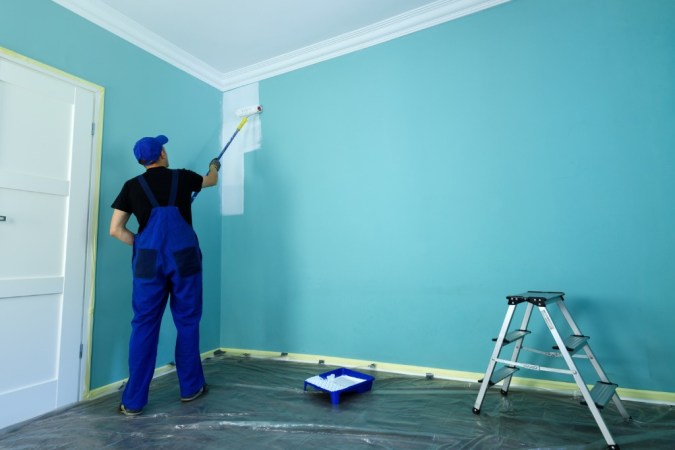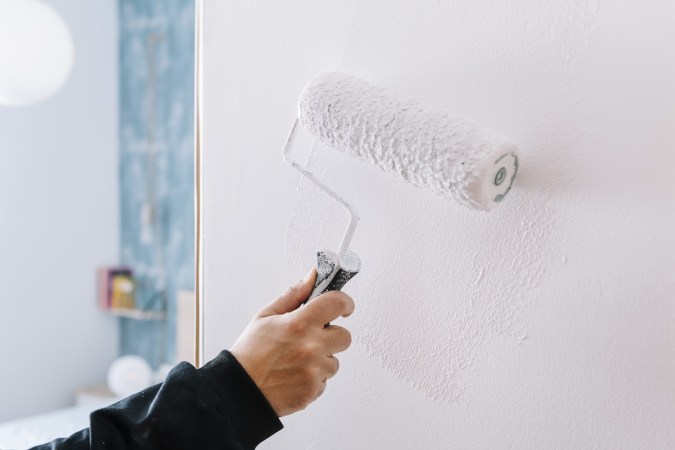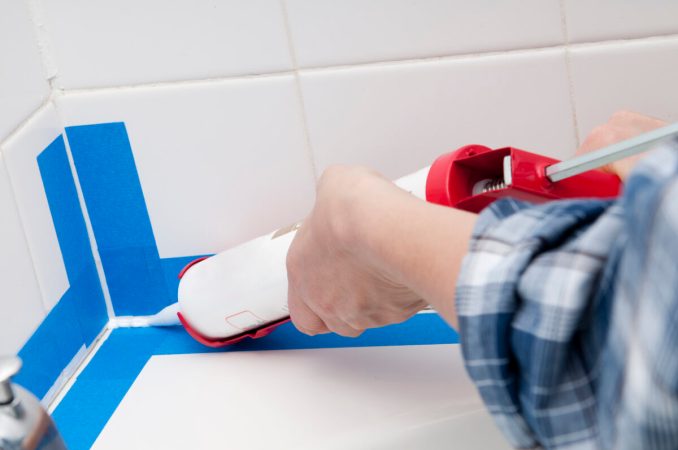We may earn revenue from the products available on this page and participate in affiliate programs. Learn More ›
If you’re used to taking on your own renovations, painting your home’s exterior might be a natural money-saving project. But before you start positioning that ladder, here are the equipment, safety, and stress factors you should review.
Types of Houses and Features
Some houses are easier to paint, others more difficult. Which is yours?
How tall is your home?
Mike Lyster of Mike Lyster Painting and Wallcovering in Oshkosh, WI, started out providing exterior painting services more than 28 years ago. He suggests that older, taller homes would be best left to a pro. Dick Seitz, Director of Communication and Training for Valspar, one of the largest global coatings manufacturers in the world, agrees. “A one-story rambler is relatively easy. A three-story Victorian with multiple dormers is a big challenge.”
Try this as a guideline: Straight exteriors on a simple, box-shaped house make for easier work. Irregularly shaped homes of two stories or more with dormers, gingerbread, or turrets, for example, tend to make for a more time-consuming and complicated project that may suggest a professional is needed.
Any intricate designs?
On the more ornate homes, such as those of Queen Anne style, accessibility is an issue. Ladders won’t get you into their many high nooks and crannies. Homeowners need experience and the correct equipment to be able to inspect, remedy, and paint in what can be awkward positions. If your home has delicate detailing on the first floor, decide if you are the type of person who enjoys doing detail work. If you do have the patience, a first-floor project should be right for you. Those who prefer the broad strokes might be better off leaving the detail work to a pro.
Flat or sloping ground?
Seitz also suggests looking at the grade (the finished surface slant of ground ) around the house for ladder positioning. It’s a plus if all sides have flat ground up to the house. Walkouts with slopes make it difficult to safely position ladders. Also check to see if obstacles like trees, shrubs, decks, fences, vines, or electric wires will be in the way.
How much prep-work?
Examine your house for potential problems that may require extensive prep work. “Wood rot, mildew, severe peeling, or alligatoring are typical siding problems,” says Seitz. “Cracked window panes, crumbling glaze, and loose caulking around trim are other issues.” If you’re familiar with solving these problems, just be prepared that you might need a few extra days to remedy the situations. Talk with an experienced paint retailer about the problem for some potential solutions. Another option might be to consider hiring a pro to fix any extensive issues before you get started.
Do you have lead paint?
Homes built before 1978 have a good chance of having paint containing lead. If you decide to paint your home yourself, you will have to learn about how to handle and/or remove it safely.
Tools, Materials, Costs
Each home project will vary. If you have determined your needs and already own the equipment, your decision may be easier. But be sure to price out the rental or purchase of tools and equipment. Then compare the price of everything you need to rent and buy to estimates from at least three local professional companies who will bring all of it with them.
Lifts and ladders
Do you need ladders, scaffolding, planks, or lifts? While a one-story home may only require a ladder, a multi-story house may need not only larger ladders but perhaps scaffolding and planks or a lift. While you may be able to rent needed equipment, consider if you will be comfortable working at heights, says Lyster.
Prep materials
Preparing the house is the first step, and cleaning it is the number one job, says Seitz. Basic cleaning supplies include scrub brushes, pails, bleach for mildew, a cleaning agent such as TSP (trisodium phosphate), and a hose with spray nozzle.
Tip: Consider power washers to clean exterior surfaces. “They do a good job of removing loose paint and surface dirt, but they don’t usually remove heavy chalk, which is created by oxidation of the previous coatings,” says Seitz. Check into hand and eye protection for this equipment and follow the guidelines.
Have drop cloths, rags, and masking tape for around critical areas such as windows. Lyster suggests canvas drop cloths instead of plastic so the grass or flowers underneath are not cooked in the sun.
Paint removers
If you have many areas of blistering or peeling paint, a good amount of scraping may be ahead. Carbide blade scrapers will be needed if a fair amount of scraping is involved. Also try using an old, dry paint brush to sweep dust away. Just be sure to use dust masks to protect your lungs.
Chemical removers may be necessary if the paint has to be softened to be removed, as is the case with many older homes with coats of paint. “Pressure washing should never be used to take off paint because it can ruin wood siding,” says Lyster.
Power sanding? That can be dangerous because it can release many toxic ingredients into the environment. After getting rid of the loose paint, sandpaper will feather the edges smooth.
Caulking
This is a must to seal up cracks around windows and doors and to maintain flexibility and adhesion over many years, says Seitz. There are many types of caulks available. Discuss your project with your paint retailer. Before purchasing any caulk, check the manufacturer’s instructions for recommended surfaces. Make sure the caulk you have selected is paintable and remains flexible to expand and contract with your home. Caulks that are 100% silicone, for example, are not paintable.
Paint applicators
Different sizes of quality brushes are basic, and if you are a typical DIYer, you probably already have several in your workshop. Quality brushes are made for the latex, oil, or varnish paints you will apply. The brush hairs are typically of varying lengths and taper neatly. They have a ferrule, or band, that holds the bristles tightly to the handle. Quality brushes hold more paint, don’t lose bristles, paint more smoothly, and are easier to use than cheaper alternatives. Spray equipment is a possibility if the house has a lot of flat surfaces with few doors or windows. Remember that even the best paint sprayers require extensive cleaning. Overspray can be a problem, so everything needs to be covered well and you will need to get familiar with the use of a sprayer. Rollers also can be a time saver and are familiar to most DIYers if they have tackled interior paint jobs.
Primer
You will need to prime any new, severely weathered, or problem areas to make sure there will be a proper seal of the surface and a smooth surface for the paint. A primer does not need to be used on a clean, dull, coated surface that is in good condition, according to Seitz. Typically you will want to choose a primer geared specifically for your job. If your paint will be 100% acrylic latex, you will want to use a 100% acrylic resins primer. If there are problem areas, however, consult with your local paint retailer for the best choice.
Paint
For most jobs, you will want 100% acrylic latex paint. “On the inside, you can get by with lesser quality, but you’ll want top-of-the-line for holding up to outside conditions. One hundred percent acrylic latex is everybody’s standard nowadays,” says Lyster. Valspar’s Seitz notes that a quality acrylic paint adheres best and holds its color much better than less expensive paints. If doing it yourself, consult a knowledgeable retailer to get the right products for the project.
Assess Experience and Skills
“If you have never painted before, even an interior surface, an exterior is probably not a good place to start. If you have painted an interior and had many problems or hated doing it, this is probably a good sign to call a pro,” says Carl Minchew, Director of Product Development for Benjamin Moore, a nationally known leader in the paint and coatings industry.
Just like any job, there are techniques and tricks to learn along the way. Lyster compares prep work to being a dental hygienist, carefully cleaning and probing for problems. Once problems are discovered, it’s vital to know or be able to find out how to remedy them. One example would be choosing a caulk and knowing how to apply it. “Put it on too thin and it expands and tears, leaving an opening for water,” says Lyster.
If painting is more your speed than prepping, consider hiring someone for just the prep work. Check for handyman services in your area for someone experienced in such work, or ask local painting contractors if they ever handle just prep work and can provide an estimate.
Have you painted before?
Knowledge of painting techniques is important. “People tend to overbrush, extending paint too far and not putting on a thick enough coat,” says Lyster. Sprayers can put on a lot of paint in a hurry but require skill to use. If a house incorporates several colors, that design feature requires more skill in “cutting in,” where the colors butt up against each other, says Seitz.
Do you know your paint needs?
Estimating paint needs will be more difficult for a DIYer. Homeowners can use Valspar’s online paint calculator. Experts also suggest talking with knowledgeable paint retailers. They can provide advice for many painting problems or direct you to experienced pros.
Can you physically handle the job?
Being able to physically handle the job is a consideration. The mind may be willing, but painting an entire house requires a certain amount of fitness. “It’s physical work and takes arm and upper body strength,” says Lyster. Climbing up and down ladders for prep and painting also figures in.
Time and Labor
Your DIY estimate depends on your skills and experience in assessing the project. For a large project, it also depends on how much reliable, qualified help you have. If enlisting family or friends, learn if they have had previous experience and whether their time restraints could leave you with a project half-finished.
Will you have time for needed prep work?
Expect to spend 30–50% of the time on proper prepping. You won’t want to skimp on surface preparation. “Most failures of exterior paint are due to poor surface preparation or structural defects that lead to water damage. Extra time spent on stripping the exterior surface is almost always worth it,” says Minchew. If the house has signs of water damage, the damage must be repaired and the source of the water corrected before painting. Check caulking around windows; replace it if necessary. Check the gutters and roof. Roof leaks, ice dams, and plugged or leaking gutters can lead to moisture problems in the exterior walls that can affect paint.
How much time do you have?
If you will only be able to handle a project for a few hours a day, a longer timetable will be necessary. Also keep weather and change of seasons in mind, since you might be mid-project as the air gets damper. A project should be clean and dry. Typically, paint needs to dry for 24 hours. If short on time, homeowners may want to look to new products, such as Sherwin-Williams Resilience, which provides resistance to moisture 50% faster.
Time available away from a job, time away from family and family duties, and household budget also should be considered.
Making the Decision
If this evaluation has left you feeling confident, a DIY project may be in your future. “Painting the exterior of a home can be a rewarding and effective way of getting the most from your money. But do think it through and avoid shortcuts. In the end, your home is probably your most valuable asset, and it pays to protect it,” says Minchew.
If you’re not sure, there is no harm in getting a couple of bids. “The cost of hiring a pro may not be as high as you think, especially if you value your leisure time,” says Minchew. Lyster suggests getting two or three bids. “Evaluate not only on the dollar but on how confident they seem.” Get references and follow up on them. Ask those homeowners how long the project took, the professionalism of the crew, if they stayed on budget, and how happy they are with the results.
If you are considering hiring a pro, Adam Potts, Communication Manager for the Painting and Decorating Contractors of America of St. Louis MO says that often the small additional cost associated with hiring a professional painting contractor is justified by the quality of the craftsmanship and the knowledge they provide. Better craftsmanship lasts longer, and knowledgeable choices (such as color, texture, and specifications) help to ensure that the right result is accomplished. He suggests visiting the PDCA Web site for its tips on hiring a contractor.
















